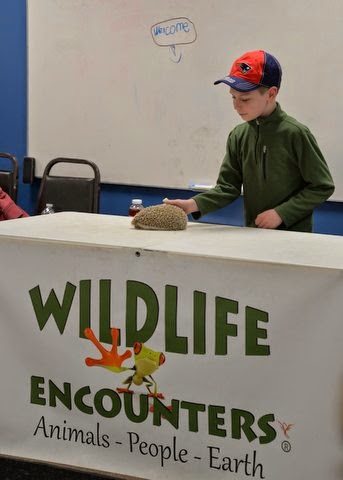The Raymond Parent-Teacher Organization, Raymond Village Library and Engineered Construction Services (ECS) of Raymond teamed up to bring area children a close encounter with exotic animals over April vacation.
 The
program, Wildlife Encounters of Rochester, New Hampshire, was an obvious thrill
for the more than 100 children and adults in attendance at the Raymond Public
Safety Building last Monday. The program also carried a serious message.
The
program, Wildlife Encounters of Rochester, New Hampshire, was an obvious thrill
for the more than 100 children and adults in attendance at the Raymond Public
Safety Building last Monday. The program also carried a serious message.
Derek,
the Encounter’s presenter, treated area preschool through elementary-aged kids
and their families to several non-native animals and was rewarded with
reactions ranging from awe to squeals of delight.
 First
up was Sid, a white cockatoo with funky feet, who performed a table-top dance
that prompted a chorus of cheers and laughter. The delight, however, died back
significantly when Sid demonstrated its ear-piercing warning cry of the jungle.
Sid, Derek explained, was actually a descendant of ancient crocodiles and
dinosaurs. Feathers replaced scales in the slow process of adaptation. Pointing
to the large black eyes on each side of the bird’s head, he had the kids repeat
a learning rhyme: “Eyes on the side, I
like to hide. Eyes in front (like an owl) I like to hunt.”
First
up was Sid, a white cockatoo with funky feet, who performed a table-top dance
that prompted a chorus of cheers and laughter. The delight, however, died back
significantly when Sid demonstrated its ear-piercing warning cry of the jungle.
Sid, Derek explained, was actually a descendant of ancient crocodiles and
dinosaurs. Feathers replaced scales in the slow process of adaptation. Pointing
to the large black eyes on each side of the bird’s head, he had the kids repeat
a learning rhyme: “Eyes on the side, I
like to hide. Eyes in front (like an owl) I like to hunt.”
As
the 90-minute presentation progressed, kids got a close-up look at creatures
more commonly seen in magazines and on the National Geographic channel.
The
African hedgehog, resembling a large, fur-lined pin cushion, hid his face when
curled up for protection. Derek challenged a front row attendee to flip the
animal onto its back. The attempt, although cheered on by the audience, met
with no success. The Komodo lizard, known as the alligator’s evil cousin in its
native land, mimics the Gila monster for protection. Joey, the wallaby, licks
soil while leaning out of its mother’s pouch to absorb nutrient rich microbes.
Some
of the animals, explained Derek, are threatened species.
The
discussion centered on how people can live their lives in ways that help
animals survive. One example involved the southwest king snake, which emerged
from a carrier wrapped around the presenter’s hand and wrist. Ranchers and
farmers import the reptiles. King snakes main food source is other snakes and
helps rid the ranch land of threatening species, such as rattlesnakes. The
practice, known as bio-mimicry, is environmentally friendly.
Other
practices, such as carbon sequestration, mentioned but not explained in depth
(due to the limited age and experiences of the young audience) deal with using
the earth’s own resources to solve the problems of modern humanity. As Derek
put it, “It’s not ‘save the earth,’ it’s ‘promote a human life support
system’.”
 Following
the presentation, audience members got the chance to pet the hedgehog and the
king snake. There was less interest in the snake.
Following
the presentation, audience members got the chance to pet the hedgehog and the
king snake. There was less interest in the snake. 

Photos
were submitted by Lisa Davison.





No comments:
Post a Comment
Your Comments Help Improve Your Community.